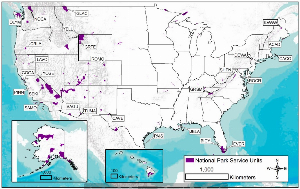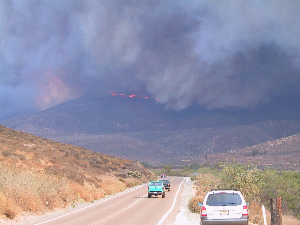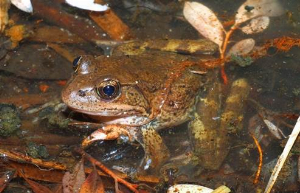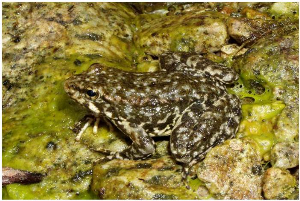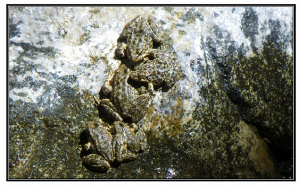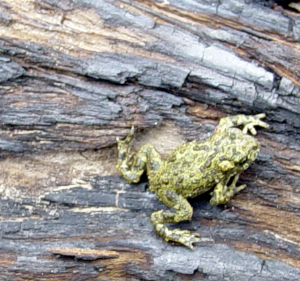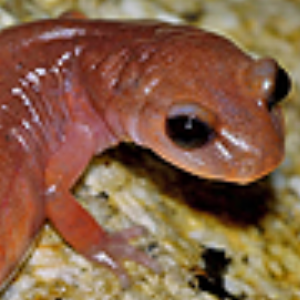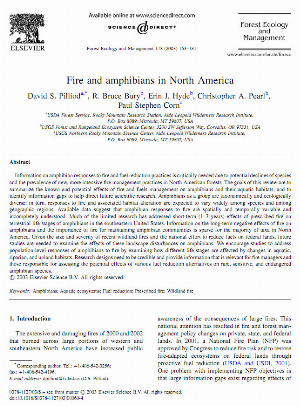Search ARMI Database
Search term(s)
Contribution Number
Search Results
26 record(s) found.
Papers & Reports Unburned habitat essential for amphibian breeding persistence following wildfire.
Authors: Larissa L Bailey; Richard Henderson; Wendy A Estes-Zumpf; Charles Rhoades; Ellie Miller; Dominique Lujan; Erin Muths
Date: 2025 | Outlet: Global Ecology and Conservation, 57, p.e03389.
Wildfire regimes are changing rapidly with widespread increase in the intensity, frequency, and duration of fire activity, especially in the western United States. Limited studies explore the impacts of wildfires on aquatic taxa and few focus on lentic habitats that are essential for amphibians, many of which are of conservation concern. We capitalized on existing pre-fire surveys for anuran species and resurveyed a random subset of wetlands across a gradient of soil burn severity to investigate the short-term effects of wildfire on a relict population of wood frogs in the southern Rocky Mountains. We also investigated whether maps created to support rapid post-fire emergency response activities (i.e., USFS BAER program) accurately characterize soil burn severity around small habitat features (i.e., ponds) that serve as important amphibian breeding and rearing habitat. We found that wood frog breeding persistence following fires was strongly influenced by the percentage of their terrestrial habitat (100m buffer surrounding breeding ponds) that was burned. Wood frog colonization probability of previously unoccupied ponds was low (~ 0.10) and unaffected by soil burn severity. Importantly, we found that remotely sensed data typically produced to predict flooding and erosion at broad (catchment) scales is a poor representation of the amount and variation in soil burn severity surrounding small habitat features (e.g., ponds), suggesting that additional field sampling is necessary to understand wildfire responses for species that rely on small habitat features. Understanding short-term geographic- and species-specific variation in response to wildfires provides the basis to explore time to recovery (e.g., when wood frogs return to burned breeding sites) or to determine if declines in breeding distributions intensify over time.
Papers & Reports Cryptic declines of small, cold-water specialists highlight potential vulnerabilities of headwater streams as climate refugia
Authors: Blake R Hossack; M LeMoine; Emily B Oja; Lisa A Eby
Date: 2023 | Outlet: Biological Conservation
Increasing temperatures and climate-driven disturbances like wildfire are a growing threat to many species,
including cold-water specialists. Montane areas and cold streams are often considered climate refugia that buffer
communities against change. However, climate refugia are often species-specific, and despite growing awareness
that life histories and habitat requirements shape responses to change, small or non-game species are often
under-represented in monitoring and planning programs. A recent study in Montana, USA, revealed much larger
warming-related declines in occupancy for small, non-game slimy sculpin (Cottus cognatus) between 1993 and
1995 and 2011–2013 than for two socially valued salmonid fishes that shape regional conservation efforts. To
broaden insight into climate change vulnerabilities of headwater stream communities, we analyzed data for
Rocky Mountain tailed frogs (Ascaphus montanus) that were collected during those same electrofishing surveys
for fishes from 241 stream reaches. Tailed frogs occupy small, cold streams and have several life-history traits
that make them sensitive to environmental change. We used a Bayesian framework to estimate occupancy,
colonization, and extinction dynamics relative to forest canopy, estimated stream temperature, and wildfire
effects. Tailed frog occupancy decreased by 19 % from 1993 to 1995 to 2011–2013. Changes in occupancy were
linked with increased extinction and reduced colonization where there were fire-driven reductions in canopy
cover, and reduced colonization of stream reaches that warmed on average 0.8 ?C during the study. Our results
highlight extensive extirpations for oft-overlooked species and emphasize the importance of including species
with diverse habitat requirements and life histories in conservation planning.
including cold-water specialists. Montane areas and cold streams are often considered climate refugia that buffer
communities against change. However, climate refugia are often species-specific, and despite growing awareness
that life histories and habitat requirements shape responses to change, small or non-game species are often
under-represented in monitoring and planning programs. A recent study in Montana, USA, revealed much larger
warming-related declines in occupancy for small, non-game slimy sculpin (Cottus cognatus) between 1993 and
1995 and 2011–2013 than for two socially valued salmonid fishes that shape regional conservation efforts. To
broaden insight into climate change vulnerabilities of headwater stream communities, we analyzed data for
Rocky Mountain tailed frogs (Ascaphus montanus) that were collected during those same electrofishing surveys
for fishes from 241 stream reaches. Tailed frogs occupy small, cold streams and have several life-history traits
that make them sensitive to environmental change. We used a Bayesian framework to estimate occupancy,
colonization, and extinction dynamics relative to forest canopy, estimated stream temperature, and wildfire
effects. Tailed frog occupancy decreased by 19 % from 1993 to 1995 to 2011–2013. Changes in occupancy were
linked with increased extinction and reduced colonization where there were fire-driven reductions in canopy
cover, and reduced colonization of stream reaches that warmed on average 0.8 ?C during the study. Our results
highlight extensive extirpations for oft-overlooked species and emphasize the importance of including species
with diverse habitat requirements and life histories in conservation planning.
Papers & Reports Looking ahead, guided by the past: The role of U.S. national parks in amphibian research and conservation
Authors: Brian J Halstead; Andrew M Ray; Erin Muths; Evan HC Grant; Rob L Grasso; Michael J Adams; Katy S Delaney; Jane Carlson; Blake R Hossack
Date: 2022-03 | Outlet: Ecological Indicators
Protected areas like national parks are essential elements of conservation because they limit human influence on the landscape, which protects biodiversity and ecosystem function. The role of national parks in conservation, however, often goes far beyond limiting human influence. The U.S. National Park Service and its system of land units contribute substantively to conservation by providing protected lands where researchers can document trends in species distributions and abundances, examine characteristics important for generating these trends, and identify and implement conservation strategies to preserve biodiversity. We reviewed the contribution of U.S. national parks to amphibian research and conservation and highlight important challenges and findings in several key areas. First, U.S. national parks were instrumental in providing strong support that amphibian declines were real and unlikely to be simply a consequence of habitat loss. Second, research in U.S. national parks provided evidence against certain hypothesized causes of decline, like UV-B radiation, and evidence for others, such as introduced species and disease. However, describing declines and identifying causes contributes to conservation only if it leads to management; importantly, U.S. national parks have implemented many conservation strategies and evaluated their effectiveness in recovering robust amphibian populations. Among these, removal of invasive species, especially fishes; conservation translocations; and habitat creation and enhancement stand out as examples of successful conservation strategies with broad applicability. Successful management for amphibians is additionally complicated by competing mandates and stakeholder interests; for example, past emphasis on increasing visitor enjoyment by introducing fish to formerly fishless lakes had devastating consequences for many amphibians. Other potential conflicts with amphibian conservation include increasing development, increased risk of introductions of disease and exotic species with increased visitation, and road mortality. Decision science and leveraging partnerships have proven to be key components of effective conservation under conflicting mandates in national parks. As resource managers grapple with large-scale drivers that are outside local control, public-private partnerships and adaptive strategies are increasing in importance. U.S. national parks have played an important role in many aspects of identifying and ameliorating the amphibian decline crisis and will continue to be essential for the conservation of amphibians in the future.
Papers & Reports Prioritizing conserved areas threatened by wildfire for monitoring and management
Authors: J Tracey; Carlton J Rochester; Stacie A Hathaway; Kristine L Preston; A Syphard; A G Vandergast; J Diffendorfer; J Franklin; J MacKenzie; T Oberbauer; S Tremor; C Winchell; Robert N Fisher
Date: 2018-09-07 | Outlet: PLoS ONE
In many parts of the world, the combined effects of habitat fragmentation and altered disturbance regimes pose a significant threat to biodiversity. This is particularly true in Mediterranean-type ecosystems (MTEs), which tend to be fire-prone, species rich, and heavily impacted by human land use. Given the spatial complexity of overlapping threats and species? vulnerability along with limited conservation budgets, methods are needed for prioritizing areas for monitoring and management in these regions. We developed a multi-criteria Pareto ranking methodology for prioritizing spatial units for conservation and applied it to fire threat, habitat fragmentation threat, species richness, and genetic biodiversity criteria in San Diego County, California, USA. We summarized the criteria and Pareto ranking results (from west to east) within the maritime, coastal, transitional, inland climate zones within San Diego County. Fire threat increased from the maritime zone eastward to the transitional zone, then decreased in the mountainous inland climate zone. Number of fires and fire return interval departure were strongly negatively correlated. Fragmentation threats, particularly road density and development density, were highest in the maritime climate zone and declined as we moved eastward and were positively correlated. Species richness criteria showed distributions among climate zones similar to that of the fire threat variables. When using species richness and fire threat criteria, most lower-ranked (higher conservation priority) units occurred in the coastal and transitional zones. When considering genetic biodiversity, lower-ranked units occurred more often in the mountainous inland zone. With Pareto ranking, there is no need to select criteria weights as part of the decision-making process. However, negative correlations and larger numbers of criteria can result in more units assigned to the same rank. Pareto ranking is broadly applicable and can be used as a standalone decision analysis method or in conjunction with other methods.
Papers & Reports Setting priorities for private land conservation in fire-prone landscapes: Are fire risk reduction and biodiversity conservation competing or compatible objectives?
Authors: A D Syphard; Van Butsic; Avi Bar-Massada; J E Keeley; J Tracey; Robert N Fisher
Date: 2016 | Outlet: Ecology and Society 21(3):2.
Although wildfire plays an important role in maintaining biodiversity in many ecosystems, fire management to protect human assets is often carried out by different agencies than those tasked for conserving biodiversity. In fact, fire risk reduction and biodiversity conservation are often viewed as competing objectives. Here we explored the role of management through private land conservation and asked whether we could identify private land acquisition strategies that fulfill the mutual objectives of biodiversity conservation and fire risk reduction, or whether the maximization of one objective comes at a detriment to the other. Using a fixed budget and number of homes slated for development, we simulated 20 years of housing growth under alternative conservation selection
strategies, and then projected the mean risk of fires destroying structures and the area and configuration of important habitat types in San Diego County, California, USA. We found clear differences in both fire risk projections and biodiversity impacts based on the way conservation lands are prioritized for selection, but these differences were split between two distinct groupings. If no conservation lands were purchased, or if purchases were prioritized based on cost or likelihood of development, both the projected fire risk and biodiversity impacts were much higher than if conservation lands were purchased in areas with high fire hazard or high species richness. Thus, conserving land focused on either of the two objectives resulted in nearly equivalent mutual benefits for both. These benefits not only resulted from preventing development in sensitive areas, but they were also due to the different housing patterns and arrangements that occurred as development was displaced from those areas. Although biodiversity conflicts may still arise using other fire management strategies, this study shows that mutual objectives can be attained through land-use planning in this region. These results likely generalize to any place where high species richness overlaps with hazardous wildland vegetation.
strategies, and then projected the mean risk of fires destroying structures and the area and configuration of important habitat types in San Diego County, California, USA. We found clear differences in both fire risk projections and biodiversity impacts based on the way conservation lands are prioritized for selection, but these differences were split between two distinct groupings. If no conservation lands were purchased, or if purchases were prioritized based on cost or likelihood of development, both the projected fire risk and biodiversity impacts were much higher than if conservation lands were purchased in areas with high fire hazard or high species richness. Thus, conserving land focused on either of the two objectives resulted in nearly equivalent mutual benefits for both. These benefits not only resulted from preventing development in sensitive areas, but they were also due to the different housing patterns and arrangements that occurred as development was displaced from those areas. Although biodiversity conflicts may still arise using other fire management strategies, this study shows that mutual objectives can be attained through land-use planning in this region. These results likely generalize to any place where high species richness overlaps with hazardous wildland vegetation.
Papers & Reports Declines revisited: long-term recovery and spatial population dynamics of tailed frog larvae after wildfire
Authors: Blake R Hossack; R K Honeycutt
Date: 2017 | Outlet: Biological Conservation
Drought has fueled an increased frequency and severity of large wildfires in many ecosystems. Despite an increase in research on wildfire effects on vertebrates, the vast majority of it has focused on short-term (<5 yrs) effects and there is still little information on the time scale of population recovery for species that decline in abundance after fire. In 2003, a large wildfire in Montana (USA) burned the watersheds of four of eight streams that we sampled for larval Rocky Mountain tailed frogs (Ascaphus montanus) in 2001. Surveys during 2004?2005 revealed reduced abundance of larvae in burned streams relative to unburned streams, with greater declines associated with increased fire extent. Rocky Mountain tailed frogs have low vagility and have several unusual life-history traits that could slow population recovery, including an extended larval period (4 yrs), delayed sexual maturity (6?8 yrs), and low fecundity (<50 eggs/yr). To determine if abundance remained depressed since the 2003 wildfire, we repeated surveys during 2014?2015 and found relative abundance of larvae in burned and unburned streams had nearly converged to pre-fire conditions within two generations. The negative effects of burn extent on larval abundance weakened >58% within 12 yrs after the fire. We also found moderate synchrony among populations in unburned streams and negative spatial autocorrelation among populations in burned streams. We suspect negative spatial autocorrelation among spatially-clustered burned streams reflected increased post-fire patchiness in resources and different rates of local recovery. Our results add to a growing body of work that suggests populations in intact ecosystems tend to be resilient to habitat changes caused by wildfire. Our results also provide important insights into recovery times of populations that have been negatively affected by severe wildfire.
Papers & Reports Trace Elements in Stormflow, Ash, and Burned Soil Following the 2009 Station Fire in Southern California
Authors: Carmen A Burton; Todd M Hoefen; Geoffrey S Plumlee; Katherine L Baumberger; Adam R Backlin; Elizabeth A Gallegos; Robert N Fisher
Date: 2016-05-04 | Outlet: PLOS One
Most research on the effects of wildfires on water quality in streams has focused on suspended sediment and nutrients in streams and water bodies, and relatively little research has examined the effects of wildfires on trace elements. The purpose of this study was two-fold: 1) to determine the effect of the 2009 Station Fire in the Angeles National Forest northeast of Los Angeles, CA on trace element concentrations in streams, and 2) compare trace elements in post-fire stormflow water quality to criteria for aquatic life to determine if trace elements reached concentrations that can harm aquatic life. Pre-storm and stormflow water-quality samples were collected in streams located inside and outside of the burn area of the Station Fire. Ash and burned soil samples were collected from several locations within the perimeter of the Station Fire. Filtered concentrations of Fe, Mn, and Hg and total concentrations of most trace elements were elevated as a result of the Station Fire. In contrast, filtered concentrations of Cu, Pb, Ni, and Se and total concentrations of Cu were elevated primarily due to storms and not the Station Fire. Total concentrations of Se and Zn were elevated as a result of both storms and the Station Fire. Suspended sediment in stormflows following the Station Fire was an important transport mechanism for trace elements. Cu, Pb, and Zn primarily originate from ash in the sediment. Fe primarily originates from burned soil in the sediment. As, Mn, and Ni originate from both ash and burned soil. Filtered concentrations of trace elements in stormwater samples affected by the Station Fire did not reach levels that were greater than criteria established for aquatic life. Total concentrations for Fe, Pb, Ni, and Zn were detected at concentrations above criteria established for aquatic life.
Papers & Reports Evolutionary dynamics of a rapidly receding southern range boundary in the threatened California Red-Legged Frog (Rana draytonii)
Authors: Jonathan Q Richmond; Kelly R Barr; Adam R Backlin; A G Vandergast; Robert N Fisher
Date: 2013-02 | Outlet: Evolutionary Applications doi:10.1111/eva.12067
Populations forming the edge of a species range are often imperiled by isolation and low genetic diversity, with proximity to human population centers being a major determinant of edge stability in modern landscapes. Since the 1960s, the California red-legged frog (Rana draytonii) has undergone extensive declines in urban-plagued southern California, where the range edge has rapidly contracted northward while shifting its cardinal orientation to an east-west trending axis. We studied the genetic structure and diversity of these front-line populations, tested for signatures of contemporary disturbance, specifically fire, and attempted to disentangle these signals from demographic events extending deeper into the past. Consistent with the genetic expectations of the ‘abundant-center’ model, we found that diversity, admixture and opportunity for random mating increases in populations sampled successively further away from the range boundary. Demographic simulations indicate that bottlenecks in peripheral isolates are associated with processes extending tens to a few hundred generations in the past, despite the demographic collapse of some populations due to recent fire-flood events. While the effects of recent disturbance have left little genetic imprint on these populations, they likely contribute to an extinction debt that will lead to continued range contraction unless management intervenes to stall or reverse the process.
Papers & Reports The precarious persistence of the endangered Sierra Madre yellow-legged frog (Rana muscosa) in southern California
Authors: Adam R Backlin; C J Hitchcock; Elizabeth A Gallegos; J L Yee; Robert N Fisher
Date: 2013 | Outlet: Oryx - International Journal of Conservation (in press)
We conducted surveys for the endangered Sierra Madre yellow-legged frog (Rana muscosa) throughout southern California to evaluate their current distribution and status. Surveys were conducted between 2000 and 2009 at 150 unique streams and lakes within the San Gabriel, San Bernardino, San Jacinto, and Palomar mountains of southern California. Of the 150 survey locations only nine small, geographically isolated, populations were detected across the four mountain ranges. The nine R. muscosa populations all tested positive for the amphibian chytrid fungus (Batrachochytrium dendrobatidis). Our data show that when R. muscosa is known to be present, it is highly detectable (89%) from a single visit during the frogs active season. We estimate there were only 166 adult frogs that remained in the wild in 2009. From our research, it appears that R. muscosa populations in southern California are extremely vulnerable to natural and stochastic events and may become extirpated in the near future without intervention.
Papers & Reports Disease in a dynamic landscape: Host behavior and wildfire reduce amphibian chytrid infection
Authors: Blake R Hossack; W H Lowe; J L Ware; P. Stephen Corn
Date: 2013 | Outlet: Biological Conservation 157: 293-299
Disturbances are often expected to magnify effects of disease, but these effects may depend on the ecology, behavior, and life history of both hosts and pathogens. In many ecosystems, wildfire is the dominant natural disturbance and thus could directly or indirectly affect dynamics of many diseases. To determine how probability of infection by the aquatic fungus Batrachochytrium dendrobatidis (Bd) varies relative to habitat use by individuals, wildfire, and host characteristics, we sampled 404 boreal toads (Anaxyrus boreas boreas) across Glacier National Park, Montana (USA). Bd causes chytridiomycosis, an emerging infectious disease linked with widespread amphibian declines, including the boreal toad. Probability of infection was similar for females and the combined group of males and juveniles. However, only 9% of terrestrial toads were infected compared to >30% of aquatic toads, and toads captured in recently burned areas were half as likely to be infected as toads in unburned areas. We suspect these large differences in infection reflect habitat choices by individuals that affect pathogen exposure and persistence, especially in burned forests where warm, arid conditions could limit Bd growth. Our results show that natural disturbances such as wildfire and the resulting diverse habitats can influence infection across large landscapes, potentially maintaining local refuges and host behaviors that facilitate evolution of disease resistance.
Papers & Reports Interactive effects of wildfire, forest management, and isolation on amphibian and parasite abundance
Authors: Blake R Hossack; W H Lowe; R K Honeycutt; S A Parks; P. Stephen Corn
Date: 2013 | Outlet: Ecological Applications 23: 479-492
Projected increases in wildfire and other climate-driven disturbances will affect
populations and communities worldwide, including host–parasite relationships. Research in
temperate forests has shown that wildfire can negatively affect amphibians, but this research
has occurred primarily outside of managed landscapes where interactions with human
disturbances could result in additive or synergistic effects. Furthermore, parasites represent a
large component of biodiversity and can affect host fitness and population dynamics, yet they
are rarely included in studies of how vertebrate hosts respond to disturbance. To determine
how wildfire affects amphibians and their parasites, and whether effects differ between
protected and managed landscapes, we compared abundance of two amphibians and two
nematodes relative to wildfire extent and severity around wetlands in neighboring protected
and managed forests (Montana, USA). Population sizes of adult, male long-toed salamanders
(Ambystoma macrodactylum) decreased with increased burn severity, with stronger negative
effects on isolated populations and in managed forests. In contrast, breeding population sizes
of Columbia spotted frogs (Rana luteiventris) increased with burn extent in both protected and
managed protected forests. Path analysis showed that the effects of wildfire on the two species
of nematodes were consistent with differences in their life history and transmission strategies
and the responses of their hosts. Burn severity indirectly reduced abundance of soil-transmitted
Cosmocercoides variabilis through reductions in salamander abundance. Burn severity also
directly reduced C. variabilis abundance, possibly though changes in soil conditions. For the
aquatically transmitted nematode Gyrinicola batrachiensis, the positive effect of burn extent on
density of Columbia spotted frog larvae indirectly increased parasite abundance. Our results
show that effects of wildfire on amphibians depend upon burn extent and severity, isolation,
and prior land use. Through subsequent effects on the parasites, our results also reveal how
changes in disturbance regimes can affect communities across trophic levels.
populations and communities worldwide, including host–parasite relationships. Research in
temperate forests has shown that wildfire can negatively affect amphibians, but this research
has occurred primarily outside of managed landscapes where interactions with human
disturbances could result in additive or synergistic effects. Furthermore, parasites represent a
large component of biodiversity and can affect host fitness and population dynamics, yet they
are rarely included in studies of how vertebrate hosts respond to disturbance. To determine
how wildfire affects amphibians and their parasites, and whether effects differ between
protected and managed landscapes, we compared abundance of two amphibians and two
nematodes relative to wildfire extent and severity around wetlands in neighboring protected
and managed forests (Montana, USA). Population sizes of adult, male long-toed salamanders
(Ambystoma macrodactylum) decreased with increased burn severity, with stronger negative
effects on isolated populations and in managed forests. In contrast, breeding population sizes
of Columbia spotted frogs (Rana luteiventris) increased with burn extent in both protected and
managed protected forests. Path analysis showed that the effects of wildfire on the two species
of nematodes were consistent with differences in their life history and transmission strategies
and the responses of their hosts. Burn severity indirectly reduced abundance of soil-transmitted
Cosmocercoides variabilis through reductions in salamander abundance. Burn severity also
directly reduced C. variabilis abundance, possibly though changes in soil conditions. For the
aquatically transmitted nematode Gyrinicola batrachiensis, the positive effect of burn extent on
density of Columbia spotted frog larvae indirectly increased parasite abundance. Our results
show that effects of wildfire on amphibians depend upon burn extent and severity, isolation,
and prior land use. Through subsequent effects on the parasites, our results also reveal how
changes in disturbance regimes can affect communities across trophic levels.
Papers & Reports Rapid increases and time-lagged declines in amphibian occupancy after wildfire
Authors: Blake R Hossack; W H Lowe; P. Stephen Corn
Date: 2013-02 | Outlet: Conservation Biology 27: 219–228
Climate change is expected to increase the frequency and severity of drought and wildfire. Aquatic and moisture-sensitive species, such as amphibians, may be particularly vulnerable to these modified disturbance regimes because large wildfires often occur during extended droughts and thus may compound environmental threats. However, understanding of the effects of wildfires on amphibians in forests with long fire-return intervals is limited. Numerous stand-replacing wildfires have occurred since 1988 in Glacier National Park (Montana, U.S.A.), where we have conducted long-term monitoring of amphibians. We measured responses of 3 amphibian species to fires of different sizes, severity, and age in a small geographic area with uniform management. We used data from wetlands associated with 6 wildfires that burned between 1988 and 2003 to evaluate whether burn extent and severity and interactions between wildfire and wetland isolation affected the distribution of breeding populations. We measured responses with models that accounted for imperfect detection to estimate occupancy during prefire (0–4 years) and different postfire recovery periods. For the long-toed salamander (Ambystoma macrodactylum) and Columbia spotted frog (Rana luteiventris), occupancy was not affected for 6 years after wildfire. But 7–21 years after wildfire, occupancy for both species decreased ≥25% in areas where >50% of the forest within 500 m of wetlands burned. In contrast, occupancy of the boreal toad (Anaxyrus boreas) tripled in the 3 years after low-elevation forests burned. This increase in occupancy was followed by a gradual decline. Our results show that accounting for magnitude of change and time lags is critical to understanding population dynamics of amphibians after large disturbances. Our results also inform understanding of the potential threat of increases in wildfire frequency or severity to amphibians in the region.
Papers & Reports Using multilevel spatial models to understand salamander site occupancy patterns after wildfire
Authors: Nathan D Chelgren; Michael J Adams; Larissa L Bailey; Richard B Bury
Date: 2011 | Outlet: Ecology 92:408-421
Studies of the distribution of elusive forest wildlife have suffered from the confounding of true presence with the uncertainty of detection. Occupancy modeling, which incorporates probabilities of species detection conditional on presence, is an emerging approach for reducing observation bias. However, the current likelihood modeling framework is restrictive for handling unexplained sources of variation in the response that may occur when there are dependence structures such as smaller sampling units that are nested within larger sampling units. We used multilevel Bayesian occupancy modeling to handle dependence structures and partition sources of variation in occupancy of sites by terrestrial salamanders (family Plethodontidae) within and surrounding an earlier wildfire in western Oregon, USA. Comparison of model fit favored a spatial N-mixture model that accounted for variation in salamander abundance over models that were based on binary detection/non-detection data. Though catch per unit effort was higher in burned areas than unburned, there was strong support that this pattern was due to a higher probability of capture for individuals in burned plots. Within the burn the odds of capturing an individual given it was present were https://2.06 times the odds outside the burn, reflecting reduced complexity of ground cover in the burn. There was weak support that true occupancy was lower within the burned area. While the odds of occupancy in the burn were https://0.49 times the odds outside the burn among the five species, the magnitude of variation attributed to the burn was small in comparison to variation attributed to other landscape variables and to unexplained, spatially autocorrelated random variation. While ordinary occupancy models may separate the biological pattern of interest from variation in detection probability when all sources of variation are known, the addition of random effects structures for unexplained sources of variation in occupancy and detection probability may often more appropriately represent levels of uncertainty.
Papers & Reports Conservation genetics of evolutionary lineages of the endangered mountain yellow-legged frog, Rana muscosa (Amphibia: Ranidae), in southern California
Authors: S D Schoville; T S Tustall; V T Vredenburg; Adam R Backlin; Elizabeth A Gallegos; D A Wood; Robert N Fisher
Date: 2011-05 | Outlet: Biological Conservation 144:2031-2040
Severe population declines led to the listing of southern California Rana muscosa (Ranidae) as endangered in 2002. Nine small populations inhabit watersheds in three isolated mountain ranges, the San Gabriel, San Bernardino and San Jacinto. One population from the Dark Canyon tributary in the San Jacinto Mountains has been used to establish a captive breeding population at the San Diego Zoo Institute for Conservation Research. Because these populations may still be declining, it is critical to gather information on how genetic variation is structured in these populations and what historical inter-population connectivity existed between populations. Additionally, it is not clear whether these populations are rapidly losing genetic diversity due to population bottlenecks. Using mitochondrial and microsatellite data, we examine patterns of genetic variation in southern California and one of the last remaining populations of R. muscosa in the southern Sierra Nevada. We find low levels of genetic variation within each population and evidence of genetic bottlenecks. Additionally, substantial population structure is evident, suggesting a high degree of historical isolation within and between mountain ranges. Based on estimates from a multi-population isolation with migration analysis, these populations diversified during glacial episodes of the Pleistocene, with little gene flow during population divergence. Our data demonstrate that unique evolutionary lineages of R. muscosa occupy each mountain range in southern California and should be managed separately. The captive breeding program at Dark Canyon is promising, although mitigating the loss of neutral genetic diversity relative to the natural population might require additional breeding frogs.
Papers & Reports Fire supression and the decline of Bufo boreas in Glacier National Park
Authors: M A Hagerty
Date: 2005 | Outlet: Thesis. Durham NC: Duke University
There have been documented decreases in B. boreas populations throughout Glacier National Park, but the causes are not as of yet fully understood. These toads breed preferentially in small, shallow ponds located at high elevations. Due to the high elevations, one potential cause of decline is that is currently being studied is increased UV-B radiation and its effect on disease. Another potential cause for their decline is lack of fire. Due to the particular life history of the boreal toad, a pond breeder that evolved in fire-disturbed landscape, lack of fire disturbance may play an important role in explaining the decline. The effect of fire management practices on amphibians is one of the least studied and most poorly understood possible reasons for amphibian decline.
Papers & Reports Reptile and amphibian responses to large-scale wildfires in Southern California
Authors: Carlton J Rochester; Cheryl S Brehme; D R Clark; D S Stokes; Stacie A Hathaway; Robert N Fisher
Date: 2010 | Outlet: Journal of Herpetology 44:333-351
In 2003, southern California experienced several large fires that burned thousands of hectares of wildlife habitats and conserved lands. To investigate the effects of these fires on the reptile and
amphibian communities, we compared the results from prefire herpetofauna and vegetation sampling to two years of postfire sampling across 38 burned and 17 unburned plots. The sampling plots were spread over four vegetation types and four open space areas within San Diego County. Our capture results indicated that burned chaparral and coastal sage scrub plots lost herpetofaunal species diversity after the fires and displayed a significant shift in overall community structure. Shrub and tree cover at the burned plots, averaged across the second and third postfire years, had decreased by 53% in chaparral and 75% in coastal sage scrub. Additionally, postfire herpetofauna community structure at burned plots was more similar to that found in unburned grasslands. In grassland and woodland/riparian vegetation plots, where shrub and tree cover was not significantly affected by fires, we found no differences in the herpetofaunal species diversity or community composition. At the individual species level, Sceloporus occidentalis was the most abundant reptile in these areas both before and after the fires. We saw increases in the net capture rates for several lizard species, including Aspidoscelis tigris, Phrynosoma coronatum, and Uta stansburiana in burned chaparral plots and Aspidoscelis hyperythra and U. stansburiana in burned coastal sage scrub plots. The toad, Bufo boreas, was detected at significantly fewer burned plots in chaparral after the fires. Additionally, we documented decreases in the number of plots occupied by lizards (Elgaria multicarinata), salamanders(Batrachoseps major), and snakes (Coluber constrictor, Lampropeltis getula, Pituophis catenifer, andMasticophis lateralis) in coastal sage scrub and chaparral after the fires. We discuss the individual species results as they relate to such life-history traits as the susceptibility to initial mortality, the response to the altered postfire habitat, and shifts in the availability of potential prey. We foresee that a continued unnatural fire regime will result in a simplification of the southern California reptile and amphibian communities.
amphibian communities, we compared the results from prefire herpetofauna and vegetation sampling to two years of postfire sampling across 38 burned and 17 unburned plots. The sampling plots were spread over four vegetation types and four open space areas within San Diego County. Our capture results indicated that burned chaparral and coastal sage scrub plots lost herpetofaunal species diversity after the fires and displayed a significant shift in overall community structure. Shrub and tree cover at the burned plots, averaged across the second and third postfire years, had decreased by 53% in chaparral and 75% in coastal sage scrub. Additionally, postfire herpetofauna community structure at burned plots was more similar to that found in unburned grasslands. In grassland and woodland/riparian vegetation plots, where shrub and tree cover was not significantly affected by fires, we found no differences in the herpetofaunal species diversity or community composition. At the individual species level, Sceloporus occidentalis was the most abundant reptile in these areas both before and after the fires. We saw increases in the net capture rates for several lizard species, including Aspidoscelis tigris, Phrynosoma coronatum, and Uta stansburiana in burned chaparral plots and Aspidoscelis hyperythra and U. stansburiana in burned coastal sage scrub plots. The toad, Bufo boreas, was detected at significantly fewer burned plots in chaparral after the fires. Additionally, we documented decreases in the number of plots occupied by lizards (Elgaria multicarinata), salamanders(Batrachoseps major), and snakes (Coluber constrictor, Lampropeltis getula, Pituophis catenifer, andMasticophis lateralis) in coastal sage scrub and chaparral after the fires. We discuss the individual species results as they relate to such life-history traits as the susceptibility to initial mortality, the response to the altered postfire habitat, and shifts in the availability of potential prey. We foresee that a continued unnatural fire regime will result in a simplification of the southern California reptile and amphibian communities.
Papers & Reports Fire and amphibians in North America
Authors: David S Pilliod; Richard B Bury; E J Hyde; Christopher A Pearl; P. Stephen Corn
Date: 2003 | Outlet: Forest Ecology and Management 178: 163–181
Information on amphibian responses to fire and fuel reduction practices is critically needed due to potential declines of species and the prevalence of new, more intensive fire management practices in North American forests. The goals of this review are to summarize the known and potential effects of fire and fuels management on amphibians and their aquatic habitats, and to identify information gaps to help direct future scientific research. Amphibians as a group are taxonomically and ecologically diverse; in turn, responses to fire and associated habitat alteration are expected to vary widely among species and among geographic regions. Available data suggest that amphibian responses to fire are spatially and temporally variable and incompletely understood. Much of the limited research has addressed short-term (1–3 years) effects of prescribed fire on terrestrial life stages of amphibians in the southeastern United States. Information on the long-term negative effects of fire on amphibians and the importance of fire for maintaining amphibian communities is sparse for the majority of taxa in North America. Given the size and severity of recent wildland fires and the national effort to reduce fuels on federal lands, future studies are needed to examine the effects of these landscape disturbances on amphibians. We encourage studies to address population-level responses of amphibians to fire by examining how different life stages are affected by changes in aquatic, riparian, and upland habitats. Research designs need to be credible and provide information that is relevant for fire managers and those responsible for assessing the potential effects of various fuel reduction alternatives on rare, sensitive, and endangered amphibian species.
Papers & Reports Amphibians and fire in longleaf pine ecosystems – Response to Schurbon and Fauth
Authors: D B Means; Kenneth C Dodd; S A Johnson; J G Palis
Date: 2004 | Outlet: Conservation Biology 18: 1149-1153
Papers & Reports Thermal characteristics of amphibian microhabitats in a fire-disturbed landscape
Authors: Blake R Hossack; Lisa A Eby; P. Stephen Corn
Date: 2009 | Outlet: Forest Ecology and Management 258: 1414–1421
Disturbance has long been a central issue in amphibian conservation, often regarding negative effects of logging or other forest management activities, but some amphibians seem to prefer disturbed habitats. After documenting increased use of recently burned forests by boreal toads (Bufo boreas), we hypothesized that burned habitats provided improved thermal opportunities in terrestrial habitats. We tested this hypothesis by conducting a radio telemetry study of habitat use (reported previously) and by using physical models that simulated the temperature of adult toads. We deployed 108 physical models in and adjacent to a 1-year old burn using a fully-replicated design with three burn severities (unburned, partial, high severity) and four microhabitats (open surface, under vegetation, under log, in burrow). Model temperatures were compared to a range of preferred temperatures in published studies. We found 70% more observations within the preferred temperature range of B. boreas in forests burned with high severity than in unburned areas. Burned forest was warmer than unburned forest across all microhabitats, but the largest relative difference was in burrows, which averaged 3 8C warmer in high-severity burn areas and remained warmer though the night. More than twice as many observations were within the preferred temperature range in high-severity burrows than in unburned burrows. Areas burned with high severity were still warmer than unburned forest 3 years after the fire. Habitat use of toads during the concurrent radio telemetry studymatched that predicted by the physical models. These results suggest there are fitness-linked benefits to toads using burned habitats, such as increased growth, fertility, and possibly disease resistance. However, increased soil temperatures that result from wildfire may be detrimental to other amphibian species that prefer cooler temperatures and stable environments. More broadly, our data illustrate the use of physical models to measure and interpret changes that amphibians may experience from disturbance, and highlight the need for research linking vital rates such as growth and survival to disturbance.
Papers & Reports Divergent patterns of abundance and age-class structure of headwater stream tadpoles in burned and unburned watersheds
Authors: Blake R Hossack; P. Stephen Corn; D Fagre
Date: 2006 | Outlet: Canadian Journal of Zoology 84: 1482–1488
Wildfire is a potential threat to many species with narrow environmental tolerances, including the Rocky Mountain Tailed Frog (Ascaphus montanus Mittleman and Myers, 1949), which inhabits a region where the frequency and intensity of wildfires is expected to increase. We compared pre- and post-fire counts of tadpoles in 8 streams in northwest Montana to determine the effects of wildfire on A. montanus. All streams were initially sampled in 2001, 2 years before 4 of them burned in a large wildfire, and were resampled during the 2 years following the fire. Counts of tadpoles were similar in the two groups of streams before the fire. After the fire, tadpoles were almost twice as abundant in unburned streams than in burned streams. The fire seemed to have the greatest negative effect on abundance of age-1 tadpoles, which was reflected in greater variation in same-stream age-class structure compared to unburned streams. Despite the apparent effect on tadpoles, we do not suspect the wildfire is an extirpation threat to populations in the streams we sampled. Studies spanning a chronosequence of fires and in other areas are needed to assess effects on A. montanus streams and to determine the severity and persistence of effects on populations.


